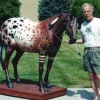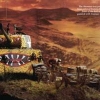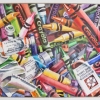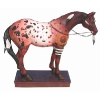
Creech, Loran
Turning Dreams into Reality
Whether it is legend or truth, he cannot say. But it was the essence of a story that Loran Creech heard long ago - that the only survivor of Custer’s battle at the Little Big Horn was a 7 th Cavalry horse that was allowed to roam the Plains like an independent, free spirit - that inspired “Horse with No Name.”
As the tale behind Loran’s Painted Pony goes, “A story is told about a rider-less Appaloosa, flamboyantly painted with symbols that portray a warrior’s bravery during battle, wandering the prairie as if in search of his master. According to this tale, the horse would never let anyone else ride him, though many tried. The lightning bolt on his face, the sun on his shoulder, the circle around his eye, the handprint on his flank, the feathers in his mane and tail marked him as a horse with powerful medicine. And so he was allowed to roam the plains freely...”
His Pony also evokes many of the themes that weave through Loran’s life: he too has moved constantly around the landscape of the American West; he has an enduring interest in history and warfare; and in some ways his art is a record of where he’s been.
Loran Creech’s journey in life began in Missouri, shortly after the Second World War. His father was a decorated veteran who fought in the South Pacific and who remained in the army through the Korean conflict. Loran, who was named after one of his dad’s “foxhole buddies,” grew up an “army brat”, moving to locations around the Midwest and southwest.
All that moving around wasn’t easy. Some years he went to two or three schools in one session. No sooner would he make friends than he would have to leave them. And he was always trying to catch up with his studies. Nor was it easy growing up with a first name no one could pronounce right, and a last name that invited teasing. Creech may be an old Scottish name, but it is also tailor-made for mockery. Everywhere he went he was called “Screech” or “Creech-ure.”
His was a decidedly blue-collar upbringing. After his father checked out of the military he went to work on large construction projects, such as building dams and skyscrapers, which meant he went where the work was and brought his family with him. There were five boys and one tomboy. What that meant was it was up to each of the children to cultivate what was unique about themselves on their own. When he wasn’t going to school or doing chores, Loran was doodling – in a notebook, “on anything I could make a mark on. I was known even to draw on brown cardboard.”
Probably because of the stories his father would tell about his wartime escapades, Loran gravitated towards military history for subject matter. He would draw extravagant Civil War battles that were accurate in every detail except one. “I had the Confederates winning every time.”
Loran’s artistic talent did not go unnoticed. He was encouraged by his mother and by his art teachers to such an extent that when he graduated from high school he decided he would go to work for Hallmark Cards. Of course no one at Hallmark knew of his ambitions until he marched into their corporate offices in Kansas City with a portfolio under his arm and announced he had arrived to help them create wonderful greeting cards.
Today, he can laugh at his naïveté, although as it turned out he did get a job with Hallmark – in the shipping and receiving room. Where he worked temporarily, until he realized how unrealistic his dreams were.
The years that followed are remembered by the term “reality.” He never went to college. He married at a relatively young age and started a family. To make a living he went to work for car dealerships, where he did everything from selling to working in the shop. He divorced.
As for his art, it was relegated to a back burner, but that didn’t mean he wasn’t doing something interesting. As a hobby he started creating miniature historical dioramas of GIs engaged in everyday activities on the war front. It was an extension of his youthful interest in assembling model airplanes, and as he soon learned, there was almost a cult following for this kind of thing. Indeed, stories about his dioramas were published in magazines, and he developed a national reputation.
It was around 1990 that his circumstances took a radical turn and art became a central part of his life. He remarried, and over coffee one morning his new wife Suzanne, sensing his dissatisfaction with the car business, asked him, “If money was no object, if you could do whatever you wanted with the rest of your life, what would you do?” He thought about it for a minute and answered, “Pursue my art.” “Then do it,” Suzanne said. “I’ll support you.”
With that support, Loran focused on his artwork. His primary medium is transparent watercolor, and occasionally he works in pen and ink. Long an admirer of Andrew Wyeth and Norman Rockwell, he found himself drawn to subject matter that is often described as “Americana,” often with a sense of irony. A lot of his paintings depict decaying elements of mankind that have been reclaimed by Nature, such as one he did of a graveyard of old gas pumps he found standing in an overgrown field in the Ozarks, off old Route 66. Although he likes to “kick around the countryside with a sketch pad and camera, turning over rocks,” sometimes he looks no further than his studio for inspiration, as with a painting he did of the bottom of a box of old crayons.
At first it was a challenge, making a good enough living from his art to get back to the notion that theirs was a two-income family. But Loran’s talent began to win him recognition. He received numerous “Best of Shows” at different art festivals. His work was accepted into the prestigious “Watercolor USA” exhibition. Galleries began contacting him about representation. He was welcomed into The Best of Missouri Hands.
While all these things advanced his career, it was his wife’s marketing savvy that turned the corner for him. Recognizing that part of being a successful artist was developing personal relationships with collectors, she began hosting a regular series of “art parties” in their home for friends and art lovers, featuring new work by Loran, along with homemade appetizers. So many people came to these events that they have begun publishing a newsletter, keeping people up-to-date with what’s happening.
The latest edition of the newsletter heralds the release of Loran’s figurine, “Horse with No Name,” the fact that the Official Autographed Edition sold out within a week, and the good news that in one more way, Loran Creech’s dream of becoming a successful artist has become a reality.
Painted Pony figurines by Loran Creech:
- "Horse With No Name" Figurine by Loran Creech
Additional Information
Where do you live?
California, Missouri. It’s no bigger than a minute, and it’s twenty miles west of Jefferson City, the capitol of Missouri. In a historic, two-story, frame house with leaded, stain-glass windows. One of the town fathers built the house in the 1880s.
Where do you do your art?
Every morning, after sharing the day’s plans with my wife, I set off, coffee cup in hand, to work in the studio. It’s not a long walk. My studio used to be the living room in the house. It’s the biggest room in the house and has the best light.
How would you describe your artistic style?
American realism. I know it sounds nostalgic and corny, but I like my work to reference the “good old days.”
What is your favorite movie?
Dances with Wolves. I’m a stickler for historical accuracy, and it’s one of the few films I’ve watched that accurately depicted American Indians. I used to think it was ludicrous when actors like Victor Mature would portray Indian chiefs.
Who is your hero?
I have three. First, my dad. He was a decorated veteran of World War II and Korea. Second, my old art teacher from my teenage years, George David. Third, and most importantly, my wife, Suzanne. She encouraged me not to worry about a corporate paycheck and to pursue an art career.
Favorite words of advice?
Embrace your dreams. Don’t let go of them, don’t let anyone talk you out of them





